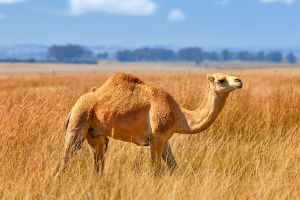The giraffe is one of nature's wonders, renowned for its long neck, graceful gait, and extraordinary size. However, the world of giraffes is filled with surprising facts that reveal their uniqueness in terms of physiology, behavior, and survival.
This article will explore five little-known facts about giraffes.
1. Blood Pressure
A giraffe’s long neck makes it distinctive and turns its heart into a marvel of nature. The giraffe has astonishingly high blood pressure to pump blood from its body to its head, more than two meters away from the heart. Its blood pressure is twice that of other mammals, reaching around 280/180 mmHg.
The giraffe's heart weighs about 11 kilograms and is 60 centimeters long, capable of forcefully pushing blood through the body. Its blood vessel walls are very thick to withstand high pressure, and the veins in the neck have special valves to prevent blood from flowing backward, avoiding dizziness or fainting when standing up suddenly.
2. Long, Dark Tongue
The giraffe's tongue is famous for its length and color—it stretches about 45-50 cm and can easily reach high tree leaves. The tongue is typically dark purple or bluish-black, and this is no coincidence. Scientists believe that this dark pigmentation helps reduce exposure to the sun, thus preventing sunburn.
Giraffe Secrets Revealed
Video by WildlifeDailiesChannel
3. Emit Low-Frequency Sounds
The world of giraffes is often considered silent since people rarely hear them make sounds. However, giraffes are not completely voiceless. Although they don’t vocalize frequently like other animals, they can produce a range of low-frequency sounds, such as humming, grunting, and coughing.
These sounds are so low in frequency that human ears find them difficult to detect. Research has shown that giraffes use these low-frequency sounds to communicate with one another, particularly at night when they "whisper" to stay connected as a group.
4. Neck Evolution: A Controversial Debate
The giraffe’s neck is its most prominent feature, but the reason for its evolution is still debated. The traditional view suggests that giraffe necks evolved to meet feeding needs—as trees grew taller, giraffes needed longer necks to reach higher leaves.
However, another theory, known as the "neck competition hypothesis," argues that giraffe necks evolved primarily due to sexual selection. Male giraffes engage in "necking" battles to compete for mating rights, with those possessing longer necks having an advantage. Thus, the neck’s length becomes a marker for attracting mates and securing dominance.
5. Four Independent Stomachs
Like other ruminants, giraffes have a multi-chambered stomach with four distinct compartments. Giraffes primarily eat tree leaves, especially acacia, which are high in fiber but hard to digest.
To efficiently extract nutrients, giraffes contemplate, much like cows, by regurgitating partially digested food back to the mouth for further chewing. This process carried out through four stomach chambers, ensures that the fibrous food is fully broken down and absorbed. This complex digestive system allows giraffes to survive in resource-scarce environments by digesting plants that would be too tough for other animals.
The world of giraffes is far more colorful than we might think, containing mysteries that scientists are still exploring. For these "giants of the savannah," every detail of their biology holds awe-inspiring survival wisdom. By learning about these lesser-known facts, we can better appreciate the wonders of nature and value these beautiful creatures even more.


